The state of interactive advertising: New formats are infusing digital ads with creativity that gets
- Fahad H

- Nov 20, 2017
- 9 min read

With the rise of mobile usage, brands have been challenged to figure out how to do more with less screen real estate and shorter attention spans.
Thanks to a combination of new technologies, more powerful mobile devices and a drive to blast through banner blindness, a new level of creativity is coming to mobile advertising as interactive ads are finally coming into their own.
A number of companies are on the forefront of interactive ads — also called engagement or immersive ads. These companies are rethinking the standard banner, using 360-degree video, augmented reality (AR) and virtual reality (VR) in advertising experiences that aim to get users engaging with ads beyond just clicking through to go to a website or download an app.
It’s not just for the sake of creativity. These companies and the brands they work with will tell you the results they’re seeing from re-imagining what digital ads prove that interactivity will only continue to gain traction.
“Interactive ads are a way to spend more valuable time with consumers,” says Kara Manatt, SVP, audience intelligence and strategy at IPG Mediabrands’ MAGNA agency. Manatt leads a research team that tests new ad formats and strategies. This year, the team conducted a large-scale test of interactive ads with four major brands in different industries.
“In general, brands are receptive to interactive ads. Most of us know that given most screens are touchable … interactive ads are the future,” says Manatt. “People expect to be able to interact with their screens, so why shouldn’t ads do that.”
Here’s a look at some of the real-world use cases and campaigns using interactive ad formats, beyond what the major platforms offer (e.g., Snapchat 3-D world lenses, Facebook canvas ads and its new effort in web-based VR, 360 experiences, Google lightbox and trial run ads).
Next-level display ads
Mobile and the use of rich interactive media has opened up new creative opportunities for display ads.
Working with New York-based PadSquad, Timberland ran a “coloring book” ad featuring a Nas video and cartoon (see the demo on mobile here). The ad features a Nas video that plays with the sound off and invites users to color and bring the cartoon to life (mobile demo).
In fewer than 40 days, the ad had accrued 59 days of video play time, with over 50 percent of video starts getting completed and more than 200,000 engagements, including coloring and click-throughs, says Padsquad.
“Units just really haven’t changed much over the years from rectangle and squares. There’s a low bar. We try to challenge brands to do things differently,” says Meehan. The mobile-only company works with clients on ideation, design and development for free and charges for media, says PadSquad CEO Daniel Meehan.
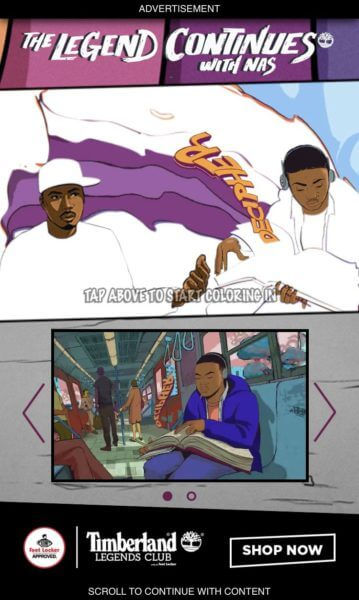
Timberland’s interactive ad from Padsquad features an image users can color and a video featuring Nas.
London-based mobile video platform LoopMe also added a coloring dimension to an ad for Yorkshire Tea featuring the storybook character the Gruffalo to promote the brand’s pledge to plant 1 million trees over five years. Users could select colors from a palate and share their finished product on social media.
The company says brand awareness was 97 percent higher among those exposed to the ad versus an unexposed control group. Perception of Yorkshire Tea as an environmentally friendly brand increased 39 percent among those exposed to the ad.
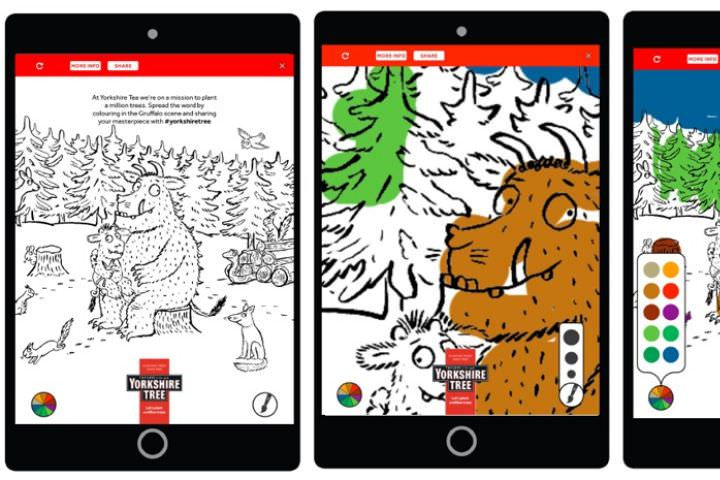
Other PadSquad interactive mobile display formats, including the title lookbook unit that flips through “pages” of an ad with a slight tilt of the user’s phone — no swiping or scrolling required. DSW used the format (mobile demo) for a spring promotion.
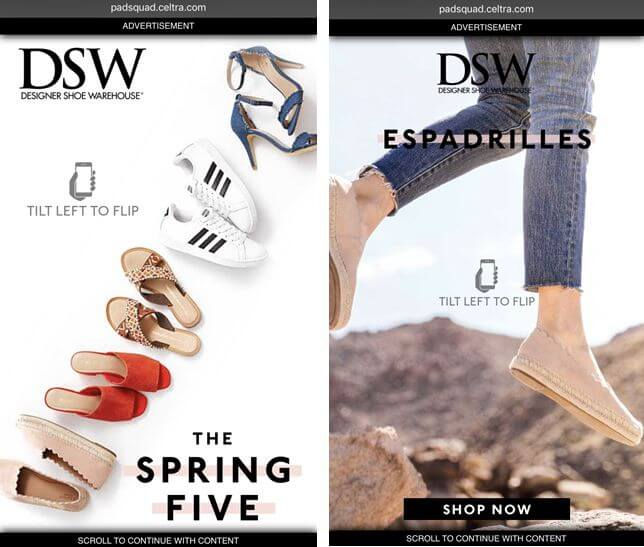
360-degree video is filling in for VR
“TV is moving to video, and mobile is where consumer activity is happening,” says Stephen Upstone, CEO and co-founder of LoopMe. Upstone says LoopMe, which recently expanded to the US, reaches some 2 billion devices globally. The firm focuses primarily on mobile video and putting video in rich media ads.
LoopMe’s Purchase Loop platform uses artificial intelligence to optimize campaigns for brand lift based on the outcome a brand wants to achieve.
“For example, a quick-serve restaurant wants to be viewed as a coffee destination,” suggests Upstone. “We can determine which video formats actually caused the consumer to change their mind about the brand or come to the desired outcome. It gives us an interesting view into what’s working.” Upstone says that in addition to brand metrics, “you can also trace the effectiveness of these ads to store visits, new car sales, etc.”
Some examples of 360 video campaigns powered by LoopMe:
The North Face ran a 360-degree gyroscope ad that tied in with weather data.
A Honda ad got users’ phones to vibrate when a car engine starts up. The company also used 360 video to let users experience the inside of the car.
A Norwegian Air campaign allowed users to click on locations they’re interested in and then to experience those locations.
Mountain Dew and its agency, OMD, used Immersv’s mobile 360 and VR marketing platform for an ad campaign promoting the VR experience, “The Professor Presents: #GotHandles.” The campaign delivered 63 percent video completion rates and 22 percent post-video click-through rates. The 360-degree trailer (shown below) promoted the VR experience on Immersv’s network of mobile 360 and VR app publishers and directed them to download the VR experience.
OmniVirt powers 360 VR ads on publisher sites, starting with an ad for GE that appeared on the The New York Times’s mobile site in July 2016. The platform can distribute 360 VR ads in standard units on publisher sites and apps, as well as in social networks like Snapchat and Twitter.
Last year, Outlyer Technologies launched its Advrtas platform and interactive 360 VR ads that employ its patent-pending Panamorphic technology. The company also creates VR and AR ads, but saw Panamorphic units as a way “to get people excited today and then learn from that and extend to platforms as more users come online,” Robert Bruza, CEO of Outlyer, told me last spring.
The units have a VR mode for viewing in headsets but also work on the web. Users have 360-degree navigation throughout a visual environment that can also include 3D or 2D computer-generated elements, photos or graphics and transactional calls to action in the ads. Users can click interactive hotspots to explore different aspects of the environment.

In this example of a 360 VR ad from Advrtas, calls to action surface as the user tours the areas of a resort.
“Video is the linchpin behind interactivity,” says PadSquad’s Meehan. The company launched an interscroller ad format called Vvital that can incorporate 360, shoppable icons, a swipeable product gallery, store locator, interactive cue cards and other interactive features.
“Many clients had been doing pre-roll and some had tested Snapchat,” said Meehan, “but for many, it was the first time to run vertical video that wasn’t placed ahead of other video content.”
ABC used the Vvital format to promote its TGIT (Thank God It’s Thursday) suite of shows (mobile demo). Meehan says in the short flight of just 11 days, the ad vertical drove more than 775,000 engagements and 239 days of total video play time.
Augmented Reality has come to the web
Upstone says their research has shown advertisers get more impact when they combine video and rich media formats. These formats will soon be more mainstream, says Upstone. “It’s going to become more commonplace. Consumers are very happy to adapt photos and videos with AR on social. Snapchat, Samsung and Facebook are helping push that.”
While VR advertising is still in its infancy, AR is rapidly gaining traction, in part because the format doesn’t depend on delivery via a headset. Also because of Snapchat. Snapchat is now running AR campaigns regularly on its platform. But AR is poised to extend well beyond Snapchat to the mobile web and other apps. Google and Apple, with ARCore and ARkit respectively, are offering developers tools to create AR experiences more easily.
For Santa Monica, California-based Vertebrae, Apple’s iOS 11 created the opportunity to open the camera onto the ad itself and use facial recognition to provide an AR experience from an ad, and at scale.
Vertebrae launched a suite of AR ad formats last month that can run on Android 5.0 and up, “but having iPhone in the game is really impactful,” says CEO Vince Cacace of the company’s AR efforts. “iOS users are more likely to engage, and we see higher camera open/allow rates than on Android.”
Vertebrae’s AR ad units work on the mobile web in Chrome and Safari. “The problem historically has been, if you’re Golden Grahams, for example, and want to have AR-triggered promotion on the box of cereal, you probably don’t have an app and don’t want to make consumers download one. Now we can build AR ad experiences over the web.”
The company offers five web AR ad templates: Virtual Try On (see how accessories look on you), Dynamic Experience Mask (facial recognition), Interior World View (inside 360 image/video), Interactive 3D Object, a Portal, and swipeable static branded filters — with plans for several more.
“Brands are going to be doing ads on Facebook and Snapchat, and we should be able to offer this on the mobile web,” said Cacace of the company’s AR efforts. “We create the assets — advertisers can also use them on Facebook and Snapchat — and we serve them through our own platform on the mobile web.”
Cacace says they are just beginning to figure out the best use cases and measurement. “On the AR side, you have all this standard data, but also all this new information from the AR experience. For instance, camera events data — in the ad for trying on Ray-Ban sunglasses, you can see which models got tried on most, for the longest and how users engaged.”
San Francisco-based VR ad network OmniVirt also offers AR and 360 video ad experiences on the web.
In September, Tel Aviv-based in-app advertising platform IronSource launched what it says is the first AR ad format to promote high-end mobile games that often use 3D (known in the industry as AAA games for their high development quality). The AR ad format was developed by IronSource’s Playworks Studio when Apple’s ARKit was still in beta. The ads use 3D assets from the original game and can run in iOS and Android apps.
IronSource AR ads superimpose in-game characters and scenarios from the advertised game onto the user’s real-world environment. “Users will be able to vanquish monsters, earn points or step into the virtual world of the game, before being prompted to install the app to continue playing,” the company said in a statement.
Virtual Reality is still in its infancy
It’s still very early days for VR content, let alone VR advertising. Most of the advertising that does exist still promotes other VR apps
USA Today’s in-house studio, GET Creative, has developed true VR and 360 VR branded stories for several advertisers, including a 360 VR campaign for True Michigan and a VR campaign for Honda.
The group is also working on creating a native VR ad format it’s calling a cubemercial that puts viewers inside a room in which brands can show products and videos on each of the walls. Google is also working on a cube-like VR ad format.
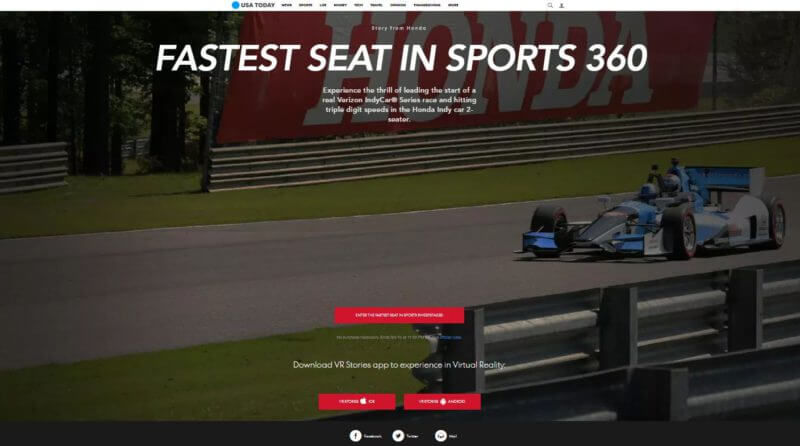
Engagement through personalization
“Advertising has always been about awareness. The only thing that’s changed is new channels,” said Eric Frankel, CEO and co-founder of personalization platform AdGreetz. “The future is ‘activation’ — hyper-relevant, data-driven personalized videos. The best way to activate people is to treat people in a personalized, hyper-relevant manner.”
AdGreetz is taking a bit of a different approach to driving engagement. The company develops and distributes hyper-personalized ads at scale across online and offline channels, including web, in-app, social networks, email outdoor and more.
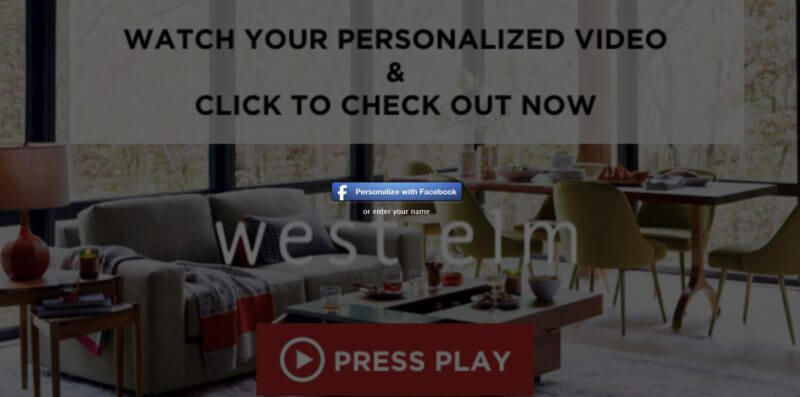
Users can log in to Facebook or type their name to see a personalized video from West Elm.
Interactive in-app & App install ads
Mobile advertising platform Leadbolt launched its version of a playable app install ad format last month that lets users test out an app before downloading it. The company says the playable ads averaged double the click-through rates and 4x improvement in conversion rate when compared to static interstitials.
Tapjoy, which specializes in in-game rewarded ads, recently launched an interactive end card for its inter-play ads. In its debut application, 20th Century Fox used the ad format to promote the film, “War for the Planet of the Apes.”
After the movie trailer, an interactive slider appears, allowing users to swipe up or down to see images and descriptions of the film’s characters, followed by the option to click out to Fandango to purchase tickets to the movie.
IronSource is launching what it calls 4D Interactive Ads this month. The ads layer interactivity on top of video content and feature interactive “choose your own adventure” journeys, taking users through various scenarios within the ad. The ads change as users make their choices and answer specific questions. Audience preference and behavior data gets funneled back to the advertisers to help them better understand their customers and prospects.
The barrier to entry in interactive is getting lower
MAGNA’s Manatt says that while some brands worried about the investment needed to create interactive ads, the agency found that they could make effective interactive ads with existing assets. “You can take existing video and make it more effective with interactivity. It’s probably going to be even more effective with new assets, but we proved it’s possible with existing assets.”
“One key angle for us was time and attention — how can we get consumers’ time?” said Manatt of the agency’s recent study. “Could interactivity turn a 15-second video into a longer user experience and drive brand KPIs? We found the average interactive ad meant 47 percent more time with consumers.”








Comments